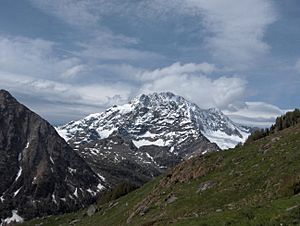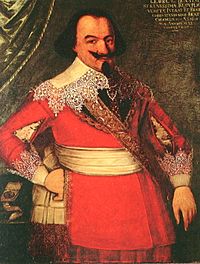Bündner Wirren facts for kids
Quick facts for kids The Bündner Wirren; or Revolt of the Leagues |
|||||||
|---|---|---|---|---|---|---|---|
| Part of the Thirty Years' War | |||||||
 Monte Disgrazia 3,678m; the Valtellina Pass |
|||||||
|
|||||||
| Belligerents | |||||||
| Commanders and leaders | |||||||
The Bündner Wirren (also known as the Graubünden disturbances or Revolt of the Leagues) was a big conflict that happened between 1618 and 1639. It took place in what is now the Swiss area of Graubünden.
This conflict started when local Catholics rebelled against their Protestant leaders. Soon, many powerful countries got involved because the fighting could affect who controlled the important Valtellina mountain passes. Countries like France, Venice, and the Duchy of Savoy supported the local group called the Three Leagues. On the other side, the Grison rebels were backed by the powerful Habsburg monarchy (which included Spain and the Holy Roman Empire). This struggle almost pulled the entire Swiss Confederation into the larger Thirty Years' War.
Why the Conflict Started: The Background
The Three Leagues were like a partnership of three smaller states. These states were the League of God's House, the League of the Ten Jurisdictions, and the Grey League. They were located in the mountain valleys around the city of Chur. Because of where they were, they controlled several very important mountain passes. The Leagues were not a single, strong country. Instead, most big decisions about outside matters were made by a public vote called a referendum.
At the start of the 1600s, powerful countries around the Leagues wanted to control the trade routes through these mountain passes. For France and Venice, these passes were vital for moving goods. For the Austrian Habsburgs, they were the quickest way between their lands in Milan and Tyrol.
In 1602, France managed to get some control over the passes. A year later, Venice bought the right to use the passes and made a 10-year alliance with the Leagues. This deal made the Spanish Habsburgs very angry. In Milan, a Spanish leader named Don Pedro Henriquez de Acevedo, Count of Fuentes stopped all trade with the Leagues. He even built a fort, the Forte di Fuentes, near Lake Como to block the entrance to the League-controlled Valtellina valley.
Politically, the Leagues were split into two main groups: one that favored the Habsburgs and another that favored Venice. In 1607, about 6,000 armed men gathered for a heated public assembly. A court was set up that first supported the French-Venetian side. This court made decisions against the Habsburg supporters, accusing them of various crimes. But soon after, the Habsburg group gained power and made decisions against the French-Venetian side.
At the same time, Protestant leaders and even some Catholics became angry with the Bishop of Chur, Giovanni V of Flugi. They said the Bishop was not working for the Leagues' best interests. They also criticized him for living outside his area. The citizens then got a court to issue an arrest warrant for the Bishop. In response, the Bishop ran away. He refused to come back for a trial. The Bishop stayed in exile until 1610. This trial showed how much religious and political conflict there was within the Leagues. After the Bishop returned, he had to flee two more times, in 1612 and 1617.
Jörg Jenatsch and the Valtellina Events
In 1618, a young and energetic leader named Jörg Jenatsch became an important figure. He joined a special court and became a leader of the group that was against the Habsburgs. This court, which was popular in the town of Thusis, declared many pro-Habsburg leaders to be outlaws. This included Rudolf Planta and his brother Pompeius Planta.
With the court's support, angry crowds attacked and arrested several pro-Habsburg leaders. Among them were a priest named Nicholas Rusca and another church leader known as Zambra. The Planta brothers managed to escape the crowds, but their homes were burned down. The captured men were brought to the court in Thusis. Zambra was accused of working with the Spanish, found guilty, and executed. Nicholas Rusca was badly beaten and died before the court could sentence him. The court also found 157 other men guilty, but they had escaped the crowds.
The harsh decisions of the Thusis court against several Catholics in the Valtellina valley led to a secret plan. This plan was to force Protestants out of this southern valley. The leader of this plan, Giacomo Robustelli, was from the Planta family and had connections to powerful groups in Madrid, Rome, and Paris.
On the night of July 18-19, 1620, a group of rebels from Valtellina, supported by troops from the Holy Roman Empire and Spain, marched into the town of Tirano. They began killing Protestants. After Tirano, they moved to Teglio, Sondrio, and other towns down the valley, killing every Protestant they found. Many people lost their lives during this terrible event. This attack forced almost all Protestants out of the valley. It also stopped more Protestants from moving in and took the Valtellina valley away from the Three Leagues' control.
Later in 1620, Pompeius Planta thought it was safe enough to return home to Rietberg Castle. However, on February 24, 1621, a group of anti-Habsburg troops, led by Jörg Jenatsch, gathered to attack the castle. Early in the morning on February 25, the troops attacked. Pompeius Planta was killed as he tried to escape. One story says he tried to hide in a chimney but was found by a dog. He was then attacked by the raiders and killed by Jörg Jenatsch with an axe.
The End of the Conflict
On January 24, 1639, Jörg Jenatsch himself was killed during a Carnival celebration by an unknown attacker dressed as a bear. Some say the attacker might have been a son of Pompeius Planta, or someone hired by the local rich families. Legend says he was killed with the very same axe he used on Pompeius Planta.
On September 3, 1639, the Leagues made an agreement with Spain. This agreement brought the Valtellina valley back under the control of the Leagues. However, they had to promise to allow Catholics to practice their faith freely. Later agreements with Austria in 1649 and 1652 also brought the Müstair and Lower Engadine valleys back under the authority of the Three Leagues.




